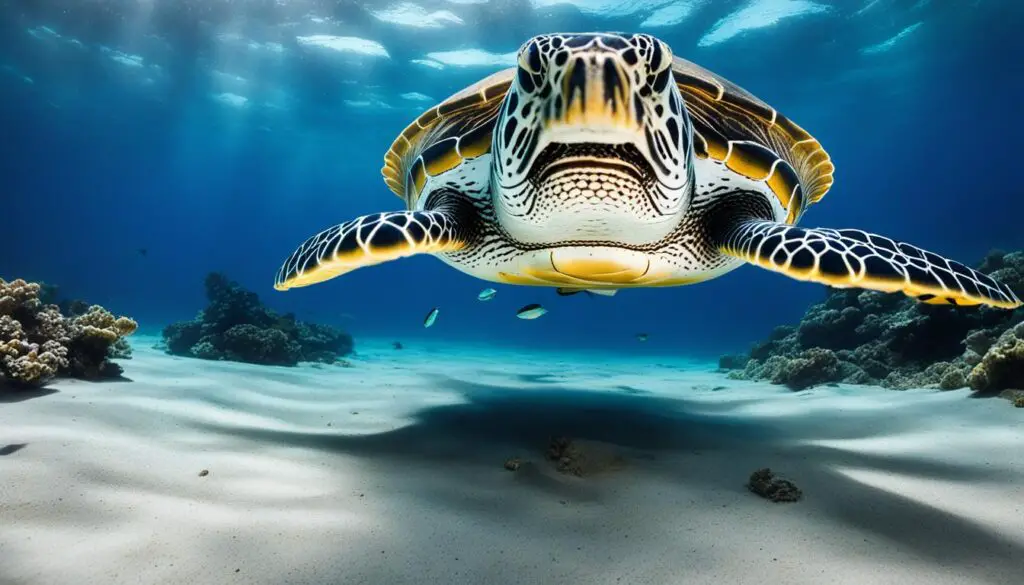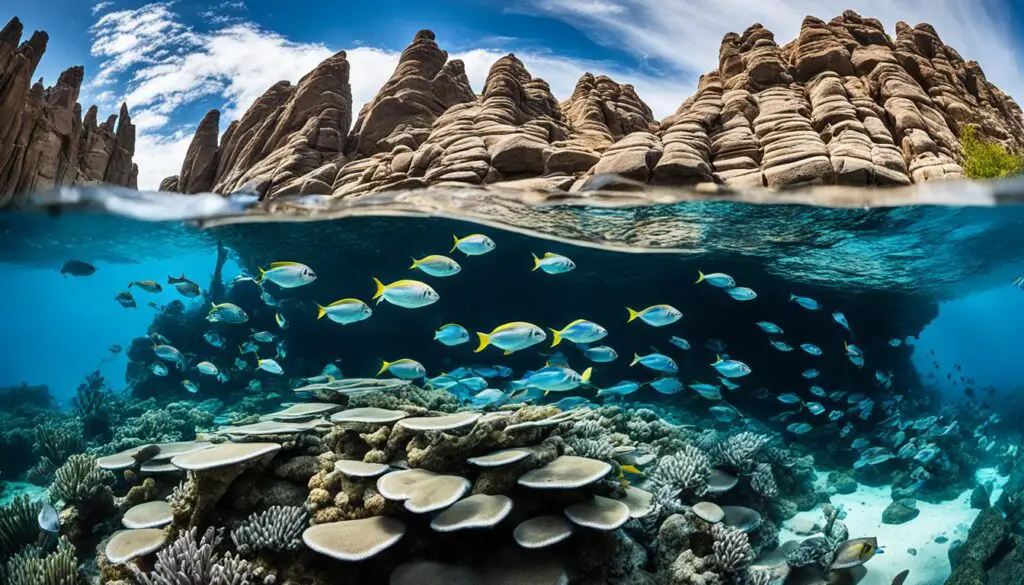Underwater photography composition is an art form that requires careful consideration and skill. By understanding the principles and techniques of composition, you can capture stunning aquatic scenes that truly stand out. With these essential tips, you’ll be able to compose your masterpiece and elevate your underwater photography to the next level.
Key Takeaways:
- Mastering underwater photography composition involves understanding the basics, such as the rule of thirds, leading lines, framing, and negative space.
- Enhancing depth and perspective in your compositions can create visually captivating images using foreground, middleground, and background elements.
- Light and color play a crucial role in underwater photography composition, including working with natural light, artificial lighting, color contrast, and color harmony.
- Experiment with different angles and perspectives to create unique underwater compositions that draw the viewer in.
- Remember to practice, be patient, and continue learning to refine your skills as an underwater photographer.
Understanding the Basics of Composition
The first step in mastering underwater photography composition is to understand the basics. By applying key principles and techniques, you can create visually captivating images that capture the essence and beauty of the underwater world. In this section, we will explore four fundamental aspects of composition: the rule of thirds, leading lines, framing, and negative space.
The Rule of Thirds
One of the essential rules in composition is the rule of thirds. This principle guides you to divide your image into nine equal parts using two horizontal and two vertical lines, resulting in a grid. Placing your main subject off-center, along one of these lines or at the intersection points, draws the viewer’s eye and creates a more harmonious and engaging composition.
Leading Lines
Leading lines are natural or man-made elements that direct the viewer’s gaze through the image. Underwater, you can find leading lines in the form of the graceful curves of coral reefs, the flowing movement of marine life, or even the trailing bubbles left by a diver. Utilizing these lines adds depth and perspective, guiding the viewer and creating a sense of exploration within the image.
Framing
Framing is a technique that involves using natural elements in the underwater environment to frame your subject. It provides context and emphasizes the importance of the main subject within the scene. By incorporating elements such as coral branches, seaweed, or even the negative space created by a swim-through, you can create a sense of depth and highlight the focal point of your composition.
Negative Space
Negative space refers to the areas of an image that are empty or unoccupied. In underwater photography, negative space can be utilized to create a sense of balance and draw attention to the main subject. By leaving open spaces in your composition, you give your subject room to breathe and allow it to stand out against the background.
Understanding these key aspects of composition is crucial for creating visually compelling underwater photographs. By applying the rule of thirds, incorporating leading lines, framing your subject, and utilizing negative space, you can enhance your compositions and capture captivating images that showcase the beauty of the underwater world.

Enhancing Depth and Perspective
Creating depth and perspective in your underwater compositions can add visual interest and dimension to your images. By incorporating elements in the foreground, middleground, and background, you can create layers that provide a sense of depth. Capturing a vibrant coral reef in the foreground, a school of fish in the middleground, and a diver exploring the background can create a dynamic composition that draws the viewer into the scene. Experimenting with different angles and perspectives can also enhance the depth and create unique compositions.
When composing an underwater photograph, consider the foreground as the closest element to the camera. This element can introduce the viewer to the scene and create a sense of proximity. It can be a rock formation, a sea plant, or a marine creature. By placing a visually captivating foreground, you can immediately grab the viewer’s attention and establish a connection.
The middleground acts as a visual bridge between the foreground and background, providing a transition and maintaining balance in the composition. It can include elements like a group of fish swimming together, a coral reef extending into the distance, or the ocean floor with its intricate textures. The middleground helps to bridge the gap between the foreground and background, creating a more complete and immersive experience for the viewer.
The background is the furthest element from the camera and sets the stage for the composition. It can be a vast expanse of open water, a distant island, or a backdrop of sunlight piercing through the surface. The background not only adds context but also contributes to the overall atmosphere and mood of the image.
To create a sense of layering and depth, experiment with different camera angles and perspectives. Shooting from a lower angle can emphasize the size and scale of the foreground elements, while shooting from a higher angle can provide a bird’s-eye view of the underwater world. Don’t be afraid to get creative and try new angles to showcase the multidimensionality of the underwater environment.

Examples of Depth and Perspective in Underwater Photography
| Foreground | Middleground | Background |
|---|---|---|
| A vibrant coral reef | A school of fish | A diver exploring |
| A sea plant | A group of marine creatures | An expanse of open water |
| A rock formation | A coral reef extending into the distance | A distant island |
Using Light and Color Effectively
When it comes to underwater photography composition, harnessing the power of light and color can make a world of difference. As a photographer, understanding how to work with both natural light and artificial lighting can greatly impact the mood and ambiance of your images.
Utilizing natural light can create stunning and ethereal effects in your underwater compositions. The gentle rays of sunlight shining through the water can cast beautiful patterns and shadows, adding depth and dimension to your photos. It’s important to be aware of the time of day and the direction of the sun, as these factors can greatly affect the quality and intensity of the natural light.
In addition to natural light, incorporating artificial lighting can bring vibrancy and highlight specific details in your underwater images. LED strobes or dive lights can be used to illuminate and enhance the colors of marine life and the surrounding environment. By experimenting with different angles and intensities, you can create captivating compositions that showcase the intricate beauty of the underwater world.
Color contrast and harmony are essential aspects of underwater photography composition. By capturing the vibrant hues of marine life against the contrasting backdrop of the ocean, you can create visually striking compositions. The contrasting colors help draw attention to your subject and make it stand out from the surrounding elements.
On the other hand, paying attention to color harmony is equally important. Combining complementary or analogous colors, such as the tranquil blues and greens of the ocean, can create a visually pleasing and balanced image. The harmonious colors work together to create a sense of unity and coherence in your composition, resulting in a more aesthetically pleasing photograph.
FAQ
What is underwater photography composition?
Underwater photography composition is the art of arranging and organizing elements within an underwater scene to create visually appealing and impactful images.
Why is composition important in underwater photography?
Composition is crucial in underwater photography because it helps guide the viewer’s eye, adds depth and perspective to the image, and enhances the overall visual impact of the photograph.
What is the rule of thirds in underwater photography composition?
The rule of thirds is a fundamental principle that suggests dividing the image into nine equal parts using two horizontal and two vertical lines. Placing key elements of the photograph along these lines or at their intersection points can create a more balanced and visually pleasing composition.
How can leading lines be used in underwater photography composition?
Leading lines, such as the natural curves of coral reefs or the movement of marine life, can be used to lead the viewer’s eye through the image and add depth to the composition.
How does framing contribute to underwater photography composition?
Framing involves positioning the main subject within the natural elements of the underwater environment, such as coral formations or rock formations. This technique helps create a sense of context and highlights the importance of the subject within its surroundings.
What is negative space and how does it impact underwater photography composition?
Negative space refers to the areas of empty or unoccupied space in an image. By incorporating negative space, underwater photographers can create a sense of balance, draw attention to the main subject, and add a feeling of simplicity and elegance to the composition.
How can I create depth and perspective in my underwater compositions?
Creating depth and perspective can be achieved by incorporating elements in the foreground, middleground, and background of the image. By capturing different layers of the underwater scene, such as vibrant coral reefs, schools of fish, and divers in the background, photographers can create a visually dynamic composition that draws the viewer into the scene.
What role does light play in underwater photography composition?
Light plays a crucial role in underwater photography composition as it can impact the mood and ambiance of the image. Understanding how to work with natural sunlight or artificial lighting can help evoke certain emotions and enhance the overall visual effect.
How can color contrast be used effectively in underwater photography composition?
Color contrast, such as the vibrant hues of marine life against the blue backdrop of the ocean, can create striking compositions and draw attention to key elements within the image.
What is color harmony and how does it contribute to underwater photography composition?
Color harmony involves combining complementary or analogous colors in an image to create a visually pleasing and balanced composition. By paying attention to color relationships, underwater photographers can enhance the overall aesthetic appeal of their photographs.
